AMD Ryzen 5 2400G integrated graphics vs NVIDIA GeForce GT 1030, or Why does the computer need high-frequency memory
Hello Giktayms! We conquer the peaks again! Most recently, AMD introduced the Ryzen 2000 series processors. The first-born were the hybrid models Ryzen 5 2400G and Ryzen 3 2200G, in which the computing part, built on the basis of the Zen architecture, is combined with the integrated graphics of Radeon Vega. Armed with fast HyperX Predator RAM , we tested one of the latest products on modern games.
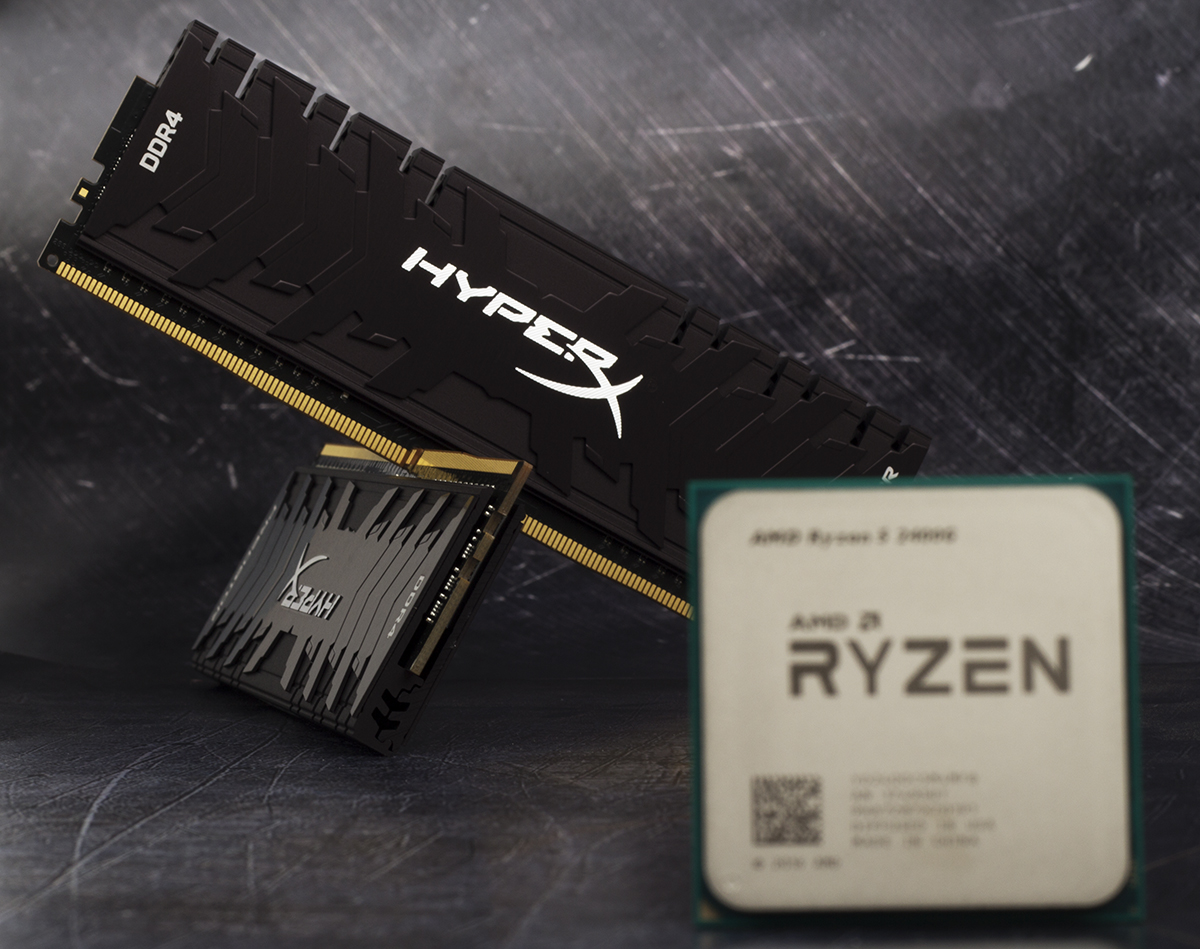
The regulars of our blog will surely remember last year’s experiment in which we tested various hybrid processors (aka APUs) on modern games. As it turned out, if there is a high-frequency memory in the system, it is quite possible to play even with APU.
However, 2018 has come. If you do not take into account the Intel Kaby Lake-G SoC-system with a Radeon RX Vega M chip, then AMD introduced the APU with the most powerful graphics core. The older model, the Ryzen 5 2400G, came to our test. And we enjoyed testing it on modern games.
Very soon, the "red" will completely update the line of central Ryzen processors. The Ryzen 5 2400G and Ryzen 3 2200G models, as mentioned earlier, are the first signs among the Zen-based desktop solutions equipped with integrated graphics.
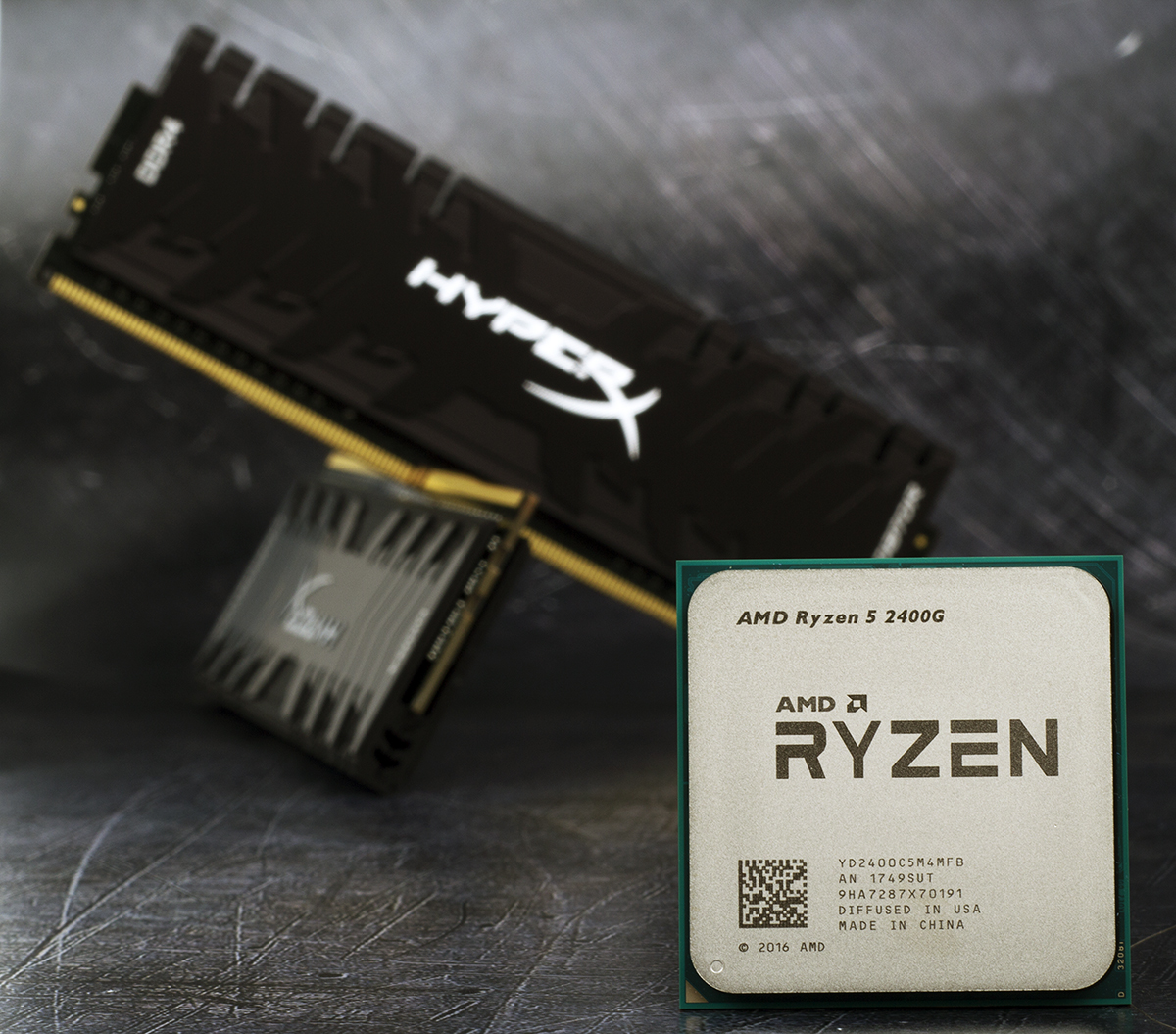
Last year, we already explored the possibilities of Ryzen chips with high-frequency RAM. As it turned out, “fermented baked milk” (so enthusiastly called the AMD products) with slow and fast “RAM” - these are two completely different in terms of system performance. It was determined which DDR4 memory is best suited for gaming PCs based on red processors. With the release of Raven Ridge processors (Ryzen 5 2400G and Ryzen 3 2200G), the situation has not changed.
As you know, Ryzen processors without integrated graphics all without exception consist of two CCX (Core Complex) modules, as well as all the necessary bindings in the form of an Infinity Fabric bus, a memory controller, and other elements. Each such module contained four cores. Depending on the model (Ryzen 3 — quad-core, Ryzen 5 — quad-core and six-core, Ryzen 7 — eight-core) the number of cores in the CCX module varied. To Ryzen 5 2400G and Ryzen 3 2200G were born, had to abandon one such module and place on the iGPU chip. As a result, the area of the Raven Ridge crystal remained almost the same - 210 against 218 mm2, but at the same time the transistor budget increased from 4.8 to 4.94 billion. In this case, the same 14-nanometer process technology is used. As known,
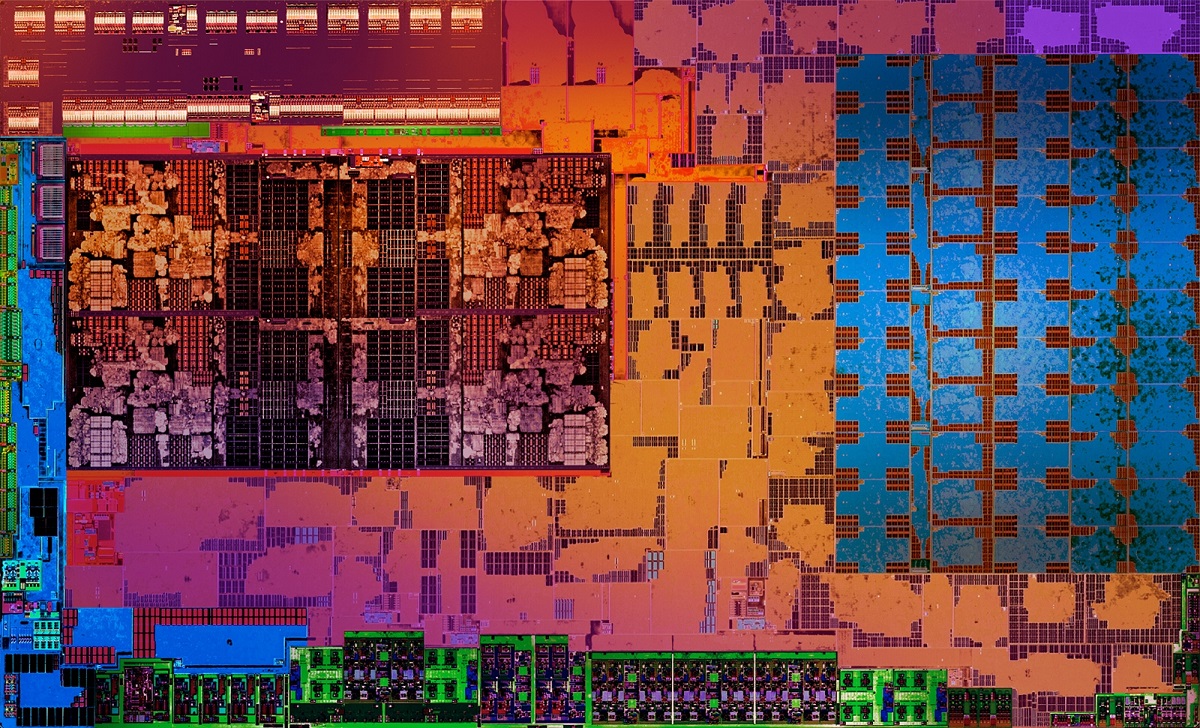
In particular, this is why the Ryzen 5 2400G and Ryzen 3 2200G have only 8 MB of L3 cache. We know that the Ryzen 5 and Ryzen 7 chips are equipped with twice as much memory. On the other hand, simplification of the CCX module operation algorithms allowed to reduce the latency of the L3 cache in Raven Ridge by about 5 clock cycles. In tasks that need 8 MB, the Ryzen 5 2400G chip will perform better than the Ryzen 5 1500X, for example. At the same time, the work of the second-level memory cache was noticeably accelerated: the delays were reduced from 17 to 13 clock cycles. As you can see, the integrated graphics in the Raven Ridge hybrid CPU is far from the only innovation. AMD engineers have done a good job over the allotted year.
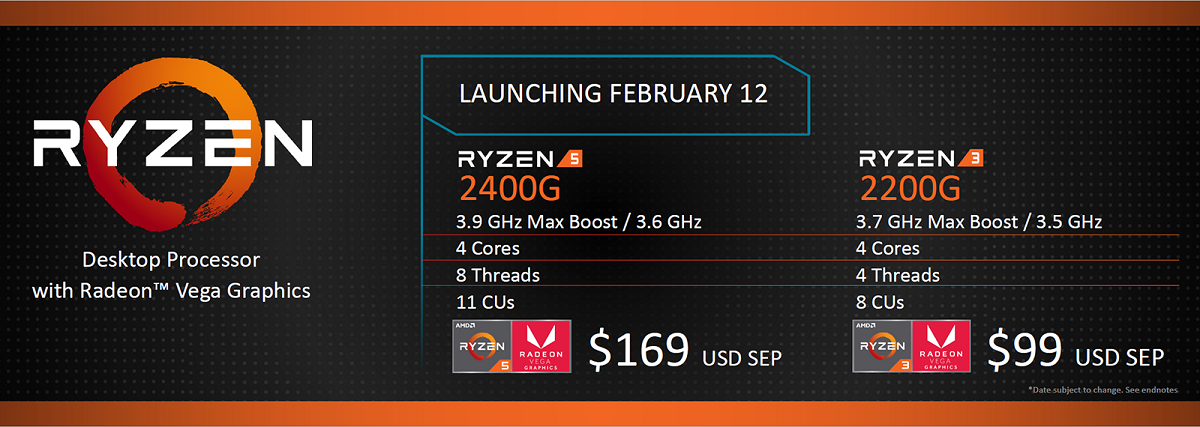
Above is a screenshot with the main features of the Ryzen 5 2400G and Ryzen 3 2200G. The older model works not only at a higher frequency, but also supports SMT technology, that is, the user can count on eight data streams to process. Ryzen 3 2200G does not support SMT.
The Ryzen 5 2400G is an ultimate model because it uses Radeon Vega 11 graphics. As the name implies, the iGPU in this chip has all 11 CU processing units (these are 704 stream processors). In terms of speed in games, this hybrid processor is even ahead of the Ryzen 7 2700U model with its 10 computing units. The Ryzen 3 2200G is equipped with eight CU-units and 512 computing threads, respectively. The chips differ in the iGPU clock frequency. So, the graphics of the older model operates at a frequency of 1.25 GHz, and the youngest - 1.1 GHz.
To consider the integrated graphics of any processor as a base for games is possible only in two cases - from hopelessness or interest for the sake of. We are sure that visitors to Geektimes do not need to explain what time we live in and why gaming video cards have become so expensive now. It is the shortage of video cards that determines the demand for such APUs. In our understanding, the purchase of processors such as the Ryzen 5 2400G and Ryzen 3 2200G will be a worthy option that will allow you to wait out these difficult times.

Judge for yourself - at the moment, Ryzen 5 2400G in Moscow retail costs an average of 11,000 rubles. For about the same money, you can buy a bundle consisting of discrete graphics GeForce GT 1030 and a dual-core Pentium G4560 chip. The first option is promising, over time, without any problems, we will buy a video card of the GeForce GTX 1060 or Radeon RX 580 level into the system and get a cool gaming system unit. The second option does not have such an advantage. That is why we decided to test the Ryzen 5 2400G, and at the same time compare its performance with the discrete graphics of the GeForce 1030 GT.
Naturally, in the case of the AMD assembly, HyperX cannot do without good and fast memory.
The memory controller of Raven Ridge processors does not just by default support DDR4-2933 RAM. Just in case, we recall that these chips are supported by any motherboards based on the AM4 platform. You only need to update the BIOS so that the device recognizes the latest.
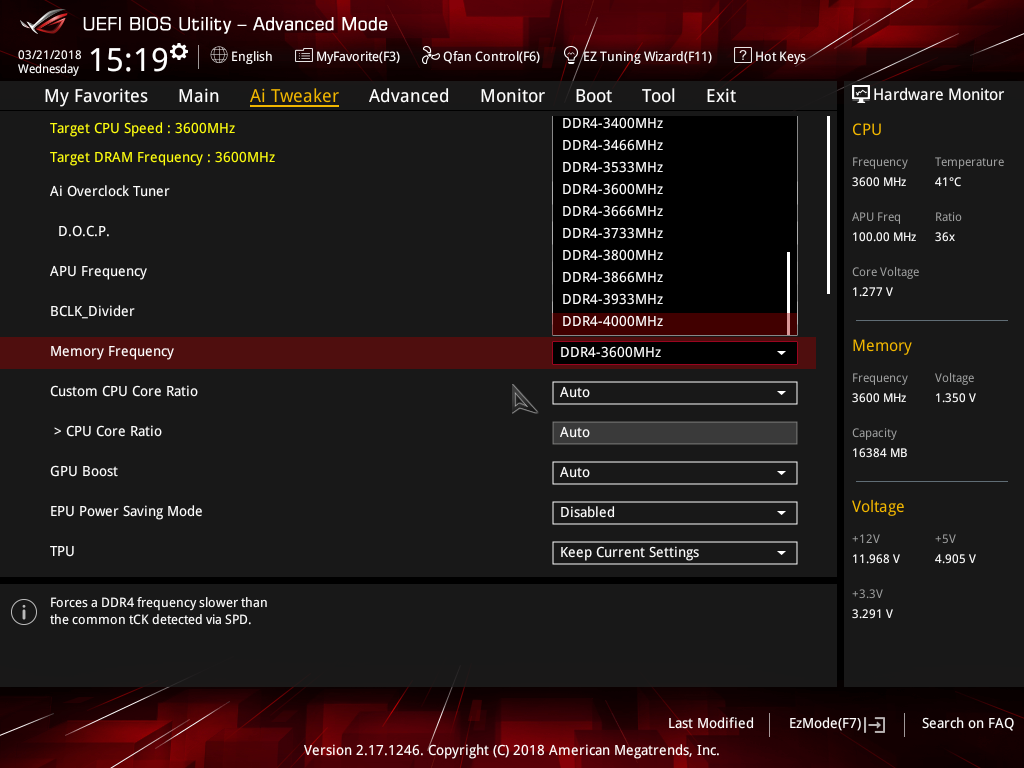
In general, AMD processors and boards support RAM up to an effective frequency of 4000 MHz. However, DDR4-3000 / 3200 kits are especially popular among users - that is why in today's testing we will focus on this frequency.
For testing, we used a quad-core Ryzen 5 2400G, an ASUS ROG STRIX X370-F GAMING motherboard, and a HyperX Predator memory kitHX436C17PB3K2 / 16 with a capacity of 16 GB. Also in the test was the video card MSI GeForce GT1030 2G LP OC. The RAM kit operates at a very high effective frequency of 3600 MHz with delays of 17-18-18-39. He earned no problems in our test bench.
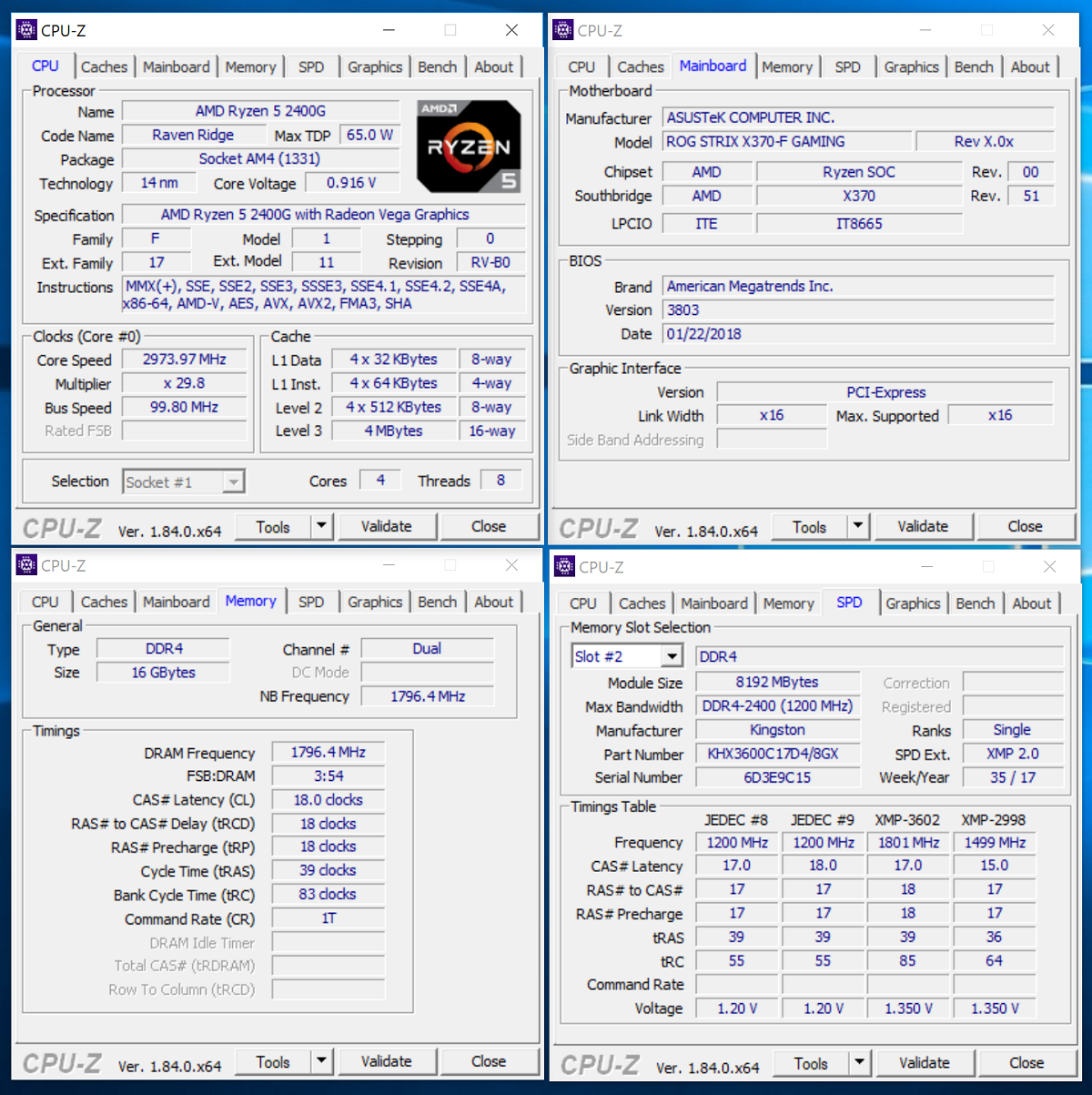
The tests were carried out in Microsoft Windows 10 x64. For the AMD stand, the driver 17.40.3701 was used. For GeForce GT 1030, the driver 391.24 was used.

By default, Ryzen 5 2400G integrated graphics is allocated 1 GB of memory, but in the BIOS settings of the motherboard this parameter can be changed up to 2 GB. For example, in ASUS motherboards, go to Advanced -> NB Configuration and select 2G in the UMA Frame Buffer Size menu.
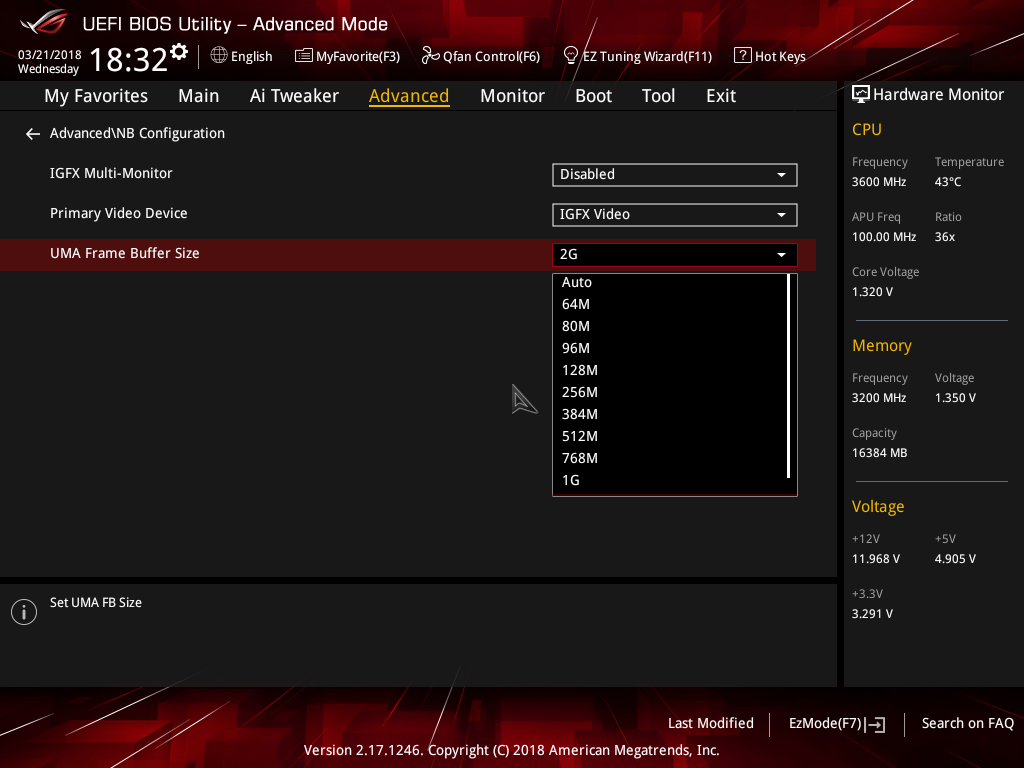
Testing was carried out in a large number of games. In the so-called AAA projects, exclusively minimal graphics quality settings were used. Testing was carried out only in Full HD resolution. The built-in graphics Ryzen 5 2400G (and the GeForce GT 1030 too) will not pull higher resolution, lower resolution in 2018 is not interesting from the word “absolutely”.
However, we suggest starting with a study of the dependence of iGPU performance on the RAM used in the stand. In our opinion, the results were more than visual.

For this experiment, we used the 3DMark Fire Strile benchmark and the iconic World of Tanks using the latest 1.0 engine (Full HD, medium graphics settings, no anti-aliasing).
We repeat, but not just because AMD recommends using DDR4-2933 and higher with Ryzen 5 2400G. If we compare the results obtained at the stand with the memory DDR4-2133 and DDR4-3200, then a faster solution is immediately ahead by 24% in 3DMark Fire Strike and 25% in World of Tanks. Becoming a quarter faster is great.
Obviously, in 2018 we are witnessing a real dawn of RAM. Then it will be even faster!
Information as an option: pay attention to the test results of the Ryzen 5 2400G in the CPU benchmark test. As you can see, with an increase in the effective frequency of RAM, there is a slight increase in the increase in the number of "parrots". What is this talking about? As you know, the frequency of the built-in north bridge of Infinity Fabric is tightly tied to the frequency of RAM. For better synchronization in Ryzen, it always runs at half the effective memory frequency. It turns out that if the computer uses a set of RAM DDR4-2133, then Infinity Fabric operates at a frequency of 1066 MHz. The north bridge is one of the most important components of the Ryzen processor, since it is he who is responsible for the interaction of CCX. The lower the frequency of the Infinity Fabric, the worse the internuclear interaction in the crystal.

But for integrated graphics, the frequency of RAM is very important. To compare Radeon Vega 11 with the GeForce GT 1030, we used the same HyperX Predator HX436C17PB3K2 / 16 kit, however, we reduced its frequency to 3200 MHz and timings to 16-15-15-36. So, in our opinion, it will be clearer.
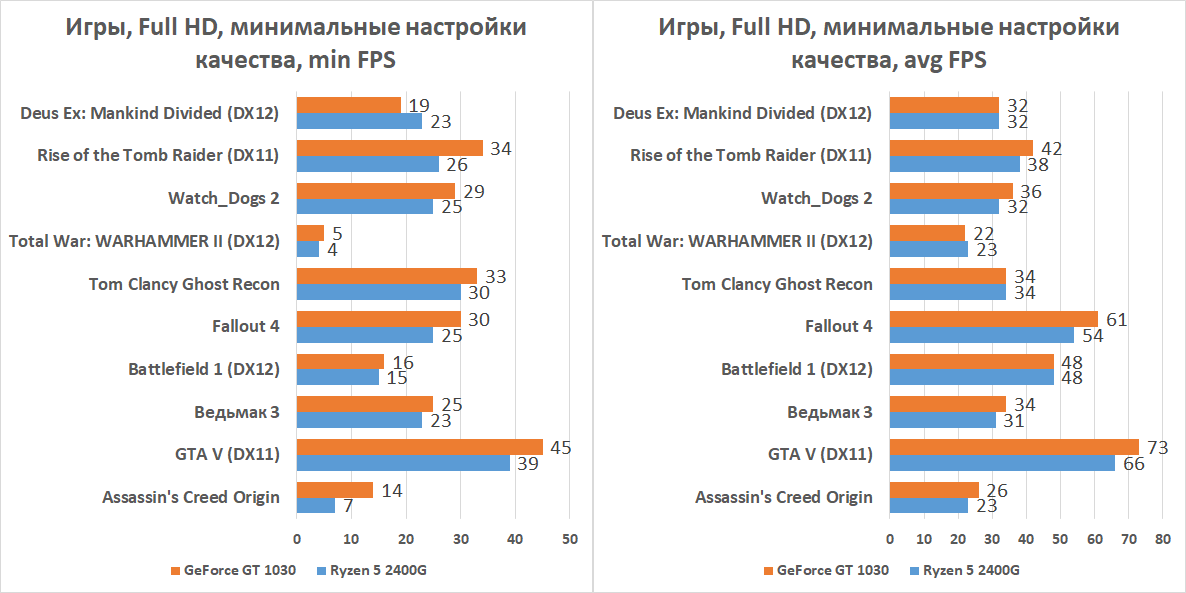
We immediately recognize that you should not wait for a miracle. However, for the first time, integrated graphics are selected so close to a full-fledged discrete graphics card. In fact, between the Ryzen 5 2400G, along with the DDR4-3200 memory and the GeForce GT 1030, you can safely put an equal sign, although formally the NVIDIA device is often ahead.
AAA-projects, even with minimal graphics quality settings, are a serious task for Radeon Vega 11. So, out of ten games, only five programs demonstrate a conditionally playable frame rate with drawdowns of at least 25 FPS. Let's be optimistic - it turns out that our glass is half full. Nevertheless, it’s a shame that in some games with a good average FPS, however, noticeable drawdowns of the frame rate are observed.
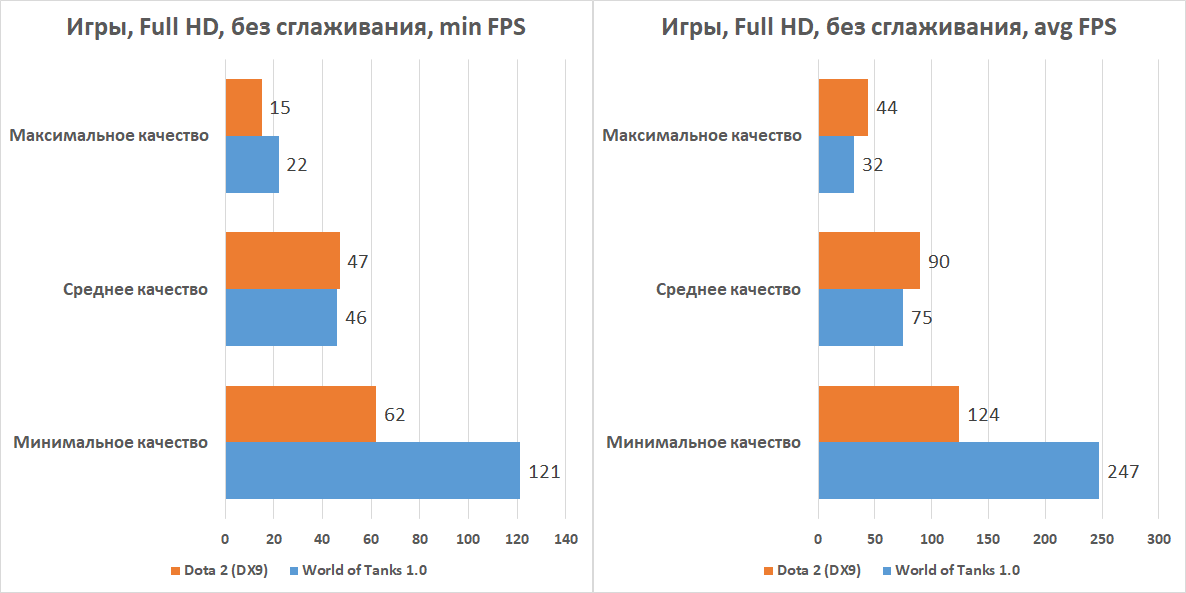
At the same time, there are games that the Ryzen 5 2400G handles like a squirrel with hazelnuts. Basically, we are talking about popular multiplayer projects, such as WoT, Dota 2, as well as undemanding games in which graphics are not the main thing. The proof of our words is shown in the graph above.
The conclusion is very simple: together with the Raven Ridge processors it is very important to use high-frequency RAM, especially if the system does not plan to use a discrete graphics card. This option is suitable for those who initially plan to play undemanding games such as Dota 2, WoT, etc. This option is also suitable for those who plan to assemble a new system unit, but have absolutely no intention of spending money on an expensive video card. In both cases, high-frequency memory will be an excellent companion to AMD processors.
___________________________________________________________________________ We
remind you that for all fans of Kingston and HyperX products, our blog runs a contest until March 28 , in which:
For more information on Kingston and HyperX products, visit the company's official website .

The regulars of our blog will surely remember last year’s experiment in which we tested various hybrid processors (aka APUs) on modern games. As it turned out, if there is a high-frequency memory in the system, it is quite possible to play even with APU.
However, 2018 has come. If you do not take into account the Intel Kaby Lake-G SoC-system with a Radeon RX Vega M chip, then AMD introduced the APU with the most powerful graphics core. The older model, the Ryzen 5 2400G, came to our test. And we enjoyed testing it on modern games.
About the new Ryzen
Very soon, the "red" will completely update the line of central Ryzen processors. The Ryzen 5 2400G and Ryzen 3 2200G models, as mentioned earlier, are the first signs among the Zen-based desktop solutions equipped with integrated graphics.

Last year, we already explored the possibilities of Ryzen chips with high-frequency RAM. As it turned out, “fermented baked milk” (so enthusiastly called the AMD products) with slow and fast “RAM” - these are two completely different in terms of system performance. It was determined which DDR4 memory is best suited for gaming PCs based on red processors. With the release of Raven Ridge processors (Ryzen 5 2400G and Ryzen 3 2200G), the situation has not changed.
As you know, Ryzen processors without integrated graphics all without exception consist of two CCX (Core Complex) modules, as well as all the necessary bindings in the form of an Infinity Fabric bus, a memory controller, and other elements. Each such module contained four cores. Depending on the model (Ryzen 3 — quad-core, Ryzen 5 — quad-core and six-core, Ryzen 7 — eight-core) the number of cores in the CCX module varied. To Ryzen 5 2400G and Ryzen 3 2200G were born, had to abandon one such module and place on the iGPU chip. As a result, the area of the Raven Ridge crystal remained almost the same - 210 against 218 mm2, but at the same time the transistor budget increased from 4.8 to 4.94 billion. In this case, the same 14-nanometer process technology is used. As known,

In particular, this is why the Ryzen 5 2400G and Ryzen 3 2200G have only 8 MB of L3 cache. We know that the Ryzen 5 and Ryzen 7 chips are equipped with twice as much memory. On the other hand, simplification of the CCX module operation algorithms allowed to reduce the latency of the L3 cache in Raven Ridge by about 5 clock cycles. In tasks that need 8 MB, the Ryzen 5 2400G chip will perform better than the Ryzen 5 1500X, for example. At the same time, the work of the second-level memory cache was noticeably accelerated: the delays were reduced from 17 to 13 clock cycles. As you can see, the integrated graphics in the Raven Ridge hybrid CPU is far from the only innovation. AMD engineers have done a good job over the allotted year.

Above is a screenshot with the main features of the Ryzen 5 2400G and Ryzen 3 2200G. The older model works not only at a higher frequency, but also supports SMT technology, that is, the user can count on eight data streams to process. Ryzen 3 2200G does not support SMT.
The Ryzen 5 2400G is an ultimate model because it uses Radeon Vega 11 graphics. As the name implies, the iGPU in this chip has all 11 CU processing units (these are 704 stream processors). In terms of speed in games, this hybrid processor is even ahead of the Ryzen 7 2700U model with its 10 computing units. The Ryzen 3 2200G is equipped with eight CU-units and 512 computing threads, respectively. The chips differ in the iGPU clock frequency. So, the graphics of the older model operates at a frequency of 1.25 GHz, and the youngest - 1.1 GHz.
Hold on here
To consider the integrated graphics of any processor as a base for games is possible only in two cases - from hopelessness or interest for the sake of. We are sure that visitors to Geektimes do not need to explain what time we live in and why gaming video cards have become so expensive now. It is the shortage of video cards that determines the demand for such APUs. In our understanding, the purchase of processors such as the Ryzen 5 2400G and Ryzen 3 2200G will be a worthy option that will allow you to wait out these difficult times.

Judge for yourself - at the moment, Ryzen 5 2400G in Moscow retail costs an average of 11,000 rubles. For about the same money, you can buy a bundle consisting of discrete graphics GeForce GT 1030 and a dual-core Pentium G4560 chip. The first option is promising, over time, without any problems, we will buy a video card of the GeForce GTX 1060 or Radeon RX 580 level into the system and get a cool gaming system unit. The second option does not have such an advantage. That is why we decided to test the Ryzen 5 2400G, and at the same time compare its performance with the discrete graphics of the GeForce 1030 GT.
Naturally, in the case of the AMD assembly, HyperX cannot do without good and fast memory.
Testing
The memory controller of Raven Ridge processors does not just by default support DDR4-2933 RAM. Just in case, we recall that these chips are supported by any motherboards based on the AM4 platform. You only need to update the BIOS so that the device recognizes the latest.

In general, AMD processors and boards support RAM up to an effective frequency of 4000 MHz. However, DDR4-3000 / 3200 kits are especially popular among users - that is why in today's testing we will focus on this frequency.
For testing, we used a quad-core Ryzen 5 2400G, an ASUS ROG STRIX X370-F GAMING motherboard, and a HyperX Predator memory kitHX436C17PB3K2 / 16 with a capacity of 16 GB. Also in the test was the video card MSI GeForce GT1030 2G LP OC. The RAM kit operates at a very high effective frequency of 3600 MHz with delays of 17-18-18-39. He earned no problems in our test bench.

The tests were carried out in Microsoft Windows 10 x64. For the AMD stand, the driver 17.40.3701 was used. For GeForce GT 1030, the driver 391.24 was used.

By default, Ryzen 5 2400G integrated graphics is allocated 1 GB of memory, but in the BIOS settings of the motherboard this parameter can be changed up to 2 GB. For example, in ASUS motherboards, go to Advanced -> NB Configuration and select 2G in the UMA Frame Buffer Size menu.

Testing was carried out in a large number of games. In the so-called AAA projects, exclusively minimal graphics quality settings were used. Testing was carried out only in Full HD resolution. The built-in graphics Ryzen 5 2400G (and the GeForce GT 1030 too) will not pull higher resolution, lower resolution in 2018 is not interesting from the word “absolutely”.
However, we suggest starting with a study of the dependence of iGPU performance on the RAM used in the stand. In our opinion, the results were more than visual.

For this experiment, we used the 3DMark Fire Strile benchmark and the iconic World of Tanks using the latest 1.0 engine (Full HD, medium graphics settings, no anti-aliasing).
We repeat, but not just because AMD recommends using DDR4-2933 and higher with Ryzen 5 2400G. If we compare the results obtained at the stand with the memory DDR4-2133 and DDR4-3200, then a faster solution is immediately ahead by 24% in 3DMark Fire Strike and 25% in World of Tanks. Becoming a quarter faster is great.
Obviously, in 2018 we are witnessing a real dawn of RAM. Then it will be even faster!
Information as an option: pay attention to the test results of the Ryzen 5 2400G in the CPU benchmark test. As you can see, with an increase in the effective frequency of RAM, there is a slight increase in the increase in the number of "parrots". What is this talking about? As you know, the frequency of the built-in north bridge of Infinity Fabric is tightly tied to the frequency of RAM. For better synchronization in Ryzen, it always runs at half the effective memory frequency. It turns out that if the computer uses a set of RAM DDR4-2133, then Infinity Fabric operates at a frequency of 1066 MHz. The north bridge is one of the most important components of the Ryzen processor, since it is he who is responsible for the interaction of CCX. The lower the frequency of the Infinity Fabric, the worse the internuclear interaction in the crystal.

But for integrated graphics, the frequency of RAM is very important. To compare Radeon Vega 11 with the GeForce GT 1030, we used the same HyperX Predator HX436C17PB3K2 / 16 kit, however, we reduced its frequency to 3200 MHz and timings to 16-15-15-36. So, in our opinion, it will be clearer.

We immediately recognize that you should not wait for a miracle. However, for the first time, integrated graphics are selected so close to a full-fledged discrete graphics card. In fact, between the Ryzen 5 2400G, along with the DDR4-3200 memory and the GeForce GT 1030, you can safely put an equal sign, although formally the NVIDIA device is often ahead.
AAA-projects, even with minimal graphics quality settings, are a serious task for Radeon Vega 11. So, out of ten games, only five programs demonstrate a conditionally playable frame rate with drawdowns of at least 25 FPS. Let's be optimistic - it turns out that our glass is half full. Nevertheless, it’s a shame that in some games with a good average FPS, however, noticeable drawdowns of the frame rate are observed.

At the same time, there are games that the Ryzen 5 2400G handles like a squirrel with hazelnuts. Basically, we are talking about popular multiplayer projects, such as WoT, Dota 2, as well as undemanding games in which graphics are not the main thing. The proof of our words is shown in the graph above.
conclusions
The conclusion is very simple: together with the Raven Ridge processors it is very important to use high-frequency RAM, especially if the system does not plan to use a discrete graphics card. This option is suitable for those who initially plan to play undemanding games such as Dota 2, WoT, etc. This option is also suitable for those who plan to assemble a new system unit, but have absolutely no intention of spending money on an expensive video card. In both cases, high-frequency memory will be an excellent companion to AMD processors.
___________________________________________________________________________ We
remind you that for all fans of Kingston and HyperX products, our blog runs a contest until March 28 , in which:
- HyperX Fury DDR4 Memory Kit (HX426C16FWK2 / 32)
- HyperX Pulsefire FPS Mouse
- Rug HyperX Fury S Pro XL
- HyperX hoodies - 2 pcs.
- HyperX T-shirts - 5 pcs.
For more information on Kingston and HyperX products, visit the company's official website .
